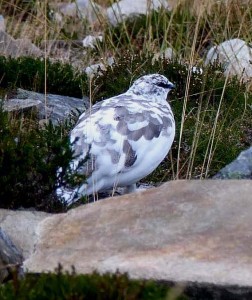
There are animals such as stoat and mountain hare that turn white in the winter for camouflage against predators. However, in the Highlands there is only one bird and that is the ptarmigan. Little wonder then that two of its many local names is “white bird of the snow” and “white one of the mountain”. The white plumage and mottled summer plumage means that it can live at high altitude all the year round and indeed around Inverness in areas such as the Cairngorm and Ben Wyvis it seldom occurs below 700 metres. Such high areas are characterised by having very little plant life, scattered boulders and bare rocks and where the snow lies longest in early summer. However, the further north you go this alpine zone, as it is called, gets lower and those few ptarmigan that do breed in north Sutherland nest much lower than 700 metres. This gets even lower further north and I remember taking an expedition to Iceland and camping the first night right down at sea level. The next morning I awoke at the noise of chicks outside the tent. There was a female ptarmigan with several chicks foraging around the tents. Apart from the white feathering in winter, ptarmigan have another adaption to combat the snowy conditions. They have feathered feet and use these to dig in the snow to find their food, berries, and these include bilberry and crowberry. However, their main food is there all the year round – the shoots of heather.
If you do not fancy the long climb from the Ullapool road up to the upper parts of Ben Wyvis there is a much easier way to see ptarmigan. In the right conditions the birds can be seen from the railway that runs up into the Cairngorm east of Aviemore. You can sit in the comfort of the carriages and, hopefully, see ptarmigan near the top with a commentary telling you all about them. If that was not enough, the admirable restaurant at the top is aptly named the Ptarmigan restaurant. However, such a tourist development brings problems for the ptarmigan. In the right weather conditions birds have been known to fly into the cables associated with such skiing developments. Then the rubbish left by people has attracted such birds as the hooded crows who will all take eggs and chicks. However, there are estimated to be around 10,000 pairs of ptarmigan in Scotland and, as to be expected, most of these occur in the Highlands.
The ptarmigan is one of the four members of the grouse family with the others being the red grouse, black grouse and the comparatively huge capercaillie. All four have been used as publicity for a wide variety of products but perhaps the most renowned is for the whiskies named after three of them. The red grouse has always been the traditional whisky but then around 2006 the black grouse whisky was added. What was remarkable about this whisky was that for each bottle sold a donation went to the RSPB for the management of areas for black grouse and many thousands of pounds were raised. This included the local famous RSPB reserve at Corrimony west of Inverness. Then the third bird was added because in August 2008 ptarmigan whisky was added to the trio. However, contrary to what many people thought, it did not go on as ptarmigan whisky. It was marketed by one of its many Scots names – snow grouse. Enthusiasts await the fourth grouse, the capercaillie – to be added to the trio! I wonder what that will be called?
Tags: highland wildlife
